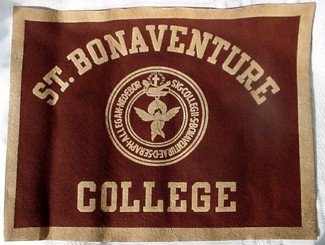Saint Bonaventure University
New York
1858




Citations in the World Almanac (listed by cover date; color information is from the previous year): brown/white (1923-1935)
The Intercollegiate Bureau of Academic Costume (IBAC) assigned St. Bonaventure College a hood lining that was “golden brown” with a white chevron, according to IBAC lists from 1927 and 1948.
However, information about St. Bonaventure College compiled by Kevin Sheard in Academic Heraldry in America (1962) and Academic Dress and Insignia of the World (1970) added an interesting detail the earlier Intercollegiate Bureau lists omit, which was that the hood lined brown with a white chevron was only for doctoral degrees. The lining of St. Bonaventure’s master’s hoods was brown above white, divided per chevron, and bachelor’s hoods had linings that were brown with two white chevrons. A 1972 IBAC list only included the description of the bachelor’s hood.
The use of multiple hood lining patterns to distinguish between different degrees is unnecessary because the sizes and/or shapes of bachelor’s, master’s, and doctor’s hoods are different.
So here the three different hood linings for St. Bonaventure’s degrees have been replaced by a single design that recalls the brown hoods and white waist cords of the Franciscan friars that founded the college: brown with a white bar. This allows St. Bonaventure to avoid duplicating the hood lining pattern the Intercollegiate Bureau had already assigned to Lehigh University in the late 1890s, which was brown with a white chevron.


St. Bonaventure Seminary and College was founded by friars from the Franciscan order, who were also the professors at the school. In 1888, a student committee was formed from members of the Duns Scotus Debating Society to select symbols for the college, including suggestions for a school color, which would be selected by the members of the Society. Less than a month later the committee brought three color suggestions to the Society for a vote: wine, because it was an unusual color not used by any other college; cream, because of its association with the regalia of Pope Leo XIII; or brown, because it was the color of the habit worn by the Franciscan Order. The Society briefly debated these three options and approved brown as the new color for the college. White was added in the 1890s, when it became more common for colleges and universities to adopt two school colors that could be attractively combined in campus decorations and athletic uniforms. White was chosen as a reference to the white cords worn by the friars around the waist of their brown robes. The most common shade of brown used by the college was a warm, earthy shade of dark brown.
